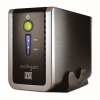@bp2008 What do you think of this new Asrock Ryzen mini as a system for running BI?
 www.newegg.com
www.newegg.com



What do you think the implications are of using USB 3.1 opposed to SATA3? My thoughts are it probably isn't that big of a deal for streaming large files because latency is less of an issue than say, running an OS, but I'm curious how much more CPU processing power the USB bus will require vs SATA (?)
Any ballpark guess how much bandwidth or, say, 5MP streams one could get with something like this on BI?
It's a good deal, even new! Gotta love Black Friday...
Are you a human?

- AMD Ryzen Embedded R1505G, DC, 2.4 GHz, 12-25W
- AMD Radeon Vega Graphics
- 2 x 260Pin SO-DIMM DDR4 2400, up to 32GB
- Dual GLAN
- 1 x HDMI, 2 x Displayport
- Supports Triple Displays
- 3 x USB 3.1, 2 x USB 2.0
- 1 x M.2 Key M, 1 x M.2 Key E
- 2 x Realtek LAN
- Intel 802.11 ac Wi-Fi + BT 4.2
- 12V DC-in
Amazon.com: Archgon MH-3622-PRD USB 3.0 Dual-Bay 3.5-inch Hard Drive Enclosure with JBOD/Raid 0/Raid 1: Computers & Accessories
Amazon.com: Archgon MH-3622-PRD USB 3.0 Dual-Bay 3.5-inch Hard Drive Enclosure with JBOD/Raid 0/Raid 1: Computers & Accessories
www.amazon.com

- Support 3.5-inch SATA hard drive x 2 (NOT for 2.5-inch hard drive)
- Support Individual, JBOD, Raid 0, Raid 1 Configurations
- USB 3.0 Transfer Speed (USB 2.0 compatible)
- 40mm Cooling Fan/Power and activity LED for HDD 1 and HDD 2. Aluminum Solid Casing
- Support up to 8TB SATA Hard Drive Per Bay
What do you think the implications are of using USB 3.1 opposed to SATA3? My thoughts are it probably isn't that big of a deal for streaming large files because latency is less of an issue than say, running an OS, but I'm curious how much more CPU processing power the USB bus will require vs SATA (?)
Any ballpark guess how much bandwidth or, say, 5MP streams one could get with something like this on BI?
It's a good deal, even new! Gotta love Black Friday...
As an Amazon Associate IPCamTalk earns from qualifying purchases.


